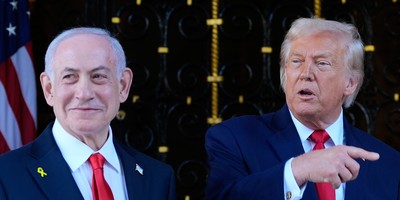President Obama announced last Thusday that he had concluded a follow-on to the 1989 Strategic Arms Reduction Treaty (START) with Russia. He characterized the cuts that it would make in the two nations’ nuclear arsenals as a major step towards his goal of ridding the world of nuclear weapons. In practice, however, the so-called “New START” accord will contribute primarily to the denuclearization of the United States and to making the world a more dangerous place. Accordingly, it would be more accurate to call it “False START.”
The first thing to note about the Obama treaty is that it confers real advantages on the Russians. For starters, the Kremlin will have to make essentially no cuts in the numbers of its deployed strategic launchers, whereas the United States will have to destroy several hundred of ours.
It is unclear at this writing whether such reductions by the U.S. will, as a practical matter, make it difficult – if not impossible – for America to preserve its strategic “Triad” of land- and sea-based ballistic missiles and long-range bombers. If so, there could be serious implications for strategic stability as the confidence of friends and foes alike in the robustness of our deterrent declines markedly.

What is clear, though, is that we will be obliged to cut back our arsenal to match the lower levels that the Russians can afford to maintain at the moment. The advisability of such a step would be debatable even if it produced a genuine equality between the two parties.
Unfortunately, the seeming equality thus established is deceptive in at least three respects:
First, the Russians are aggressively modernizing their strategic forces with both new missiles and warheads. They claim that by 2015 roughly 80% of their long-range arsenal will have been upgraded – an activity we are subsidizing by paying to dismantle their old weapon systems, freeing up funds for Moscow’s modernization programs.
By contrast, the United States has not introduced a new nuclear weapon in over fifteen years. Its missiles, submarines and bombers are, by and large, even older, with some dating back to the 1950s and ’60s. Today, the Nation has no capability to produce new nuclear weapons and could not manufacture them in quantity for many years – the only nuclear power of whom that can be said.
Recommended
Second, the Russians are reintroducing multiple, independently-targetable reentry vehicles (MIRVs) on their land-based ballistic missiles. This step could enable a break-out capacity that would allow Moscow rapidly to deploy far more weapons than its forces are allowed to have under the new START treaty. By contrast, the United States decided back in the 1980s that such a capability was “destabilizing”; it has systematically de-MIRVed its underground silo-launched intercontinental-range ballistic missiles ever since.
Third, the newly unveiled START accord fails to take into account or otherwise limit several thousand Russian “tactical” nuclear weapons. The Kremlin has focused for twenty years on such low-yield devices; some with the explosive power of the Hiroshima weapon and fitted on submarine-launched cruise missiles are deployed off our coasts today. While the administration says such armaments could be the subject of a future, bilateral treaty that makes still deeper reductions in U.S. and Russian nuclear stocks, don’t count on it. In any event, they will constitute a real, asymmetric advantage for Russia for many years to come. [This is a particularly worrisome prospect to American allies in Europe who have long relied on America’s “extended deterrence” to counteract such threatening Kremlin capabilities.
Then, there is the matter of missile defense. The Obama administration tried to finesse Russian insistence on including in the new accord language that would capture American defenses against missile attack by confining to the preamble an acknowledgement of a “relationship” between such systems and offensive forces. The United States claims that, by its nature, such preambular language is not binding. Yet, a Kremlin spokesman has already served notice that Moscow will feel free to abrogate the START follow-on treaty if it believes that U.S. missile defenses in Europe are a threat to its deterrent.
The biggest problem of all with the New START treaty, however, is that it is a product of President Obama’s fixation with “devaluing nuclear weapons” and ridding the world of them. On these grounds, he refuses to take the steps necessary to modernize America’s deterrent. Even though he professes that a nuclear-free globe will not be realized any time soon, he is condemning the nation to unilateral disarmament by allowing the steady and unavoidable obsolescence of the U.S. stockpile, and the dissipation of the workforce and infrastructure needed to maintain it, to continue unabated.
The acuteness of this obsolescence has reached a point where the directors of the nation’s nuclear laboratories have felt compelled to express strong concerns about the continued reliability of the arsenal. Even before they did so, forty-one U.S. Senators wrote President Obama warning him that they would not support ratification of a follow-on START accord unless his budget explicitly funded a modernization program for our deterrent forces. That number is more than enough to preclude the Senate advice and consent required by the Constitution.
Taken together, these factors ensure that the New START treaty will contribute to U.S. nuclear disarmament alright, but do nothing to advance the ostensible purpose of the exercise – namely, enhancing the security of this country or the world. A False START indeed, and one that should be rejected by at least thirty-four United States Senators.

























Join the conversation as a VIP Member